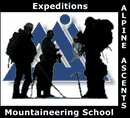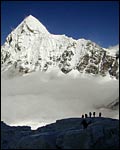While MountainZone.com viewers this spring enjoyed the day-by-day activities
of one of the most successful commercial Everest expeditions ever, the
pre-monsoon season on Mount Everest turned out to be a good one for many
teams. And though the total number of summits is likely to be well below
the record year of 2001, when, officially, 182 climbers summitted, the number
of climbers reaching the top from the Nepal side may approach the greatest
number ever when official Ministry of Tourism numbers are released in late
June.
Climbers on the mountain say the final numbers are going to be close to
those reported earlier by MountainZone.com, probably 61 total summits on
May 16, two on May 18 and approximately 35 on May 25. With a near-record
number of successful summit
climbers and only one fatal accident, 2002 will be remembered
overall as a benign and rewarding year largely free of tragedy.
(Ironically, there have been more fatal accidents on Washington State's
Mount Rainier this season than there were on Everest).
The weather on
Everest wasn't necessarily any better than a typical year, with basically
two summit windows available to climbing teams, but better forecasting made
it possible for climbers to time their attempts for a higher potential for
success.
"We were getting three separate weather forecasts at Base Camp," said Willi
Prittie, expedition leader of Alpine Ascents International's American South Col Expedition, the featured MountainZone.com expedition. "And this
year, they turned out to be more accurate than ever before. That meant we
could time our summit push when we had the greatest chance of decent
conditions for summit day. It worked."
The Alpine Ascents team put a
staggering 17 people on the summit on May 25 [click here for the climbers,
guides and Sherpa team members], the most successful ever for the Seattle-based guiding company and perhaps the most climbers ever to summit at once
on a single commercial expedition.
"It was a good year for us," said Todd Burleson, who founded Alpine Ascents
in 1989. "We put close to a dozen people on top three or four times in the
'90s, but never 17. It's a testament to our Sherpa team and guide staff, and
the motivated people who came on the expedition. Over the years, we've
gotten more precise at the logistics, and guide ratios have been increased.
When you have five guides and six clients, that's a good way to start an
expedition. And when you can get more oxygen to Camp IV than you'll need,
that's another factor in our favor."
Prittie said the expedition went very much according to plan, with a
careful acclimatization program and a good rest before the summit push.
"Spending a few days down at Deboche (approximately 12,000 feet) made a
huge difference in our physical situation and was an important factor in our
success," Prittie said. "You just can't overstate how important it is to get
some real food, some real sleep, and breathe real atmosphere when you have
to function at that level. Everyone felt much stronger after our rest
days. We had a good group to start with, and by then, everyone had really
come together."
When the weather settled enough for the summit push, all team members were
rested and ready to go, with the exception of climber Jeff Mathy. Mathy, who
up until then had been climbing strongly, came down with a debilitating
stomach ailment attributed to a cold glass of lemonade at a trekking lodge.
So he remained at Base Camp. The others climbed once again to Camp IV, and
left before midnight on the summit attempt. Al Hanna, at 72 making a summit
bid that would have anointed him the oldest person to reach the top of the
world, did not feel up to the demands of a summit push. He knows what's
required—this was Hanna's fourth attempt on Everest—so decided to turn
back and remain in the tents at Camp IV.
— Peter Potterfield, MountainZone.com Staff
 EMAIL THIS STORY TO A FRIEND
EMAIL THIS STORY TO A FRIEND



